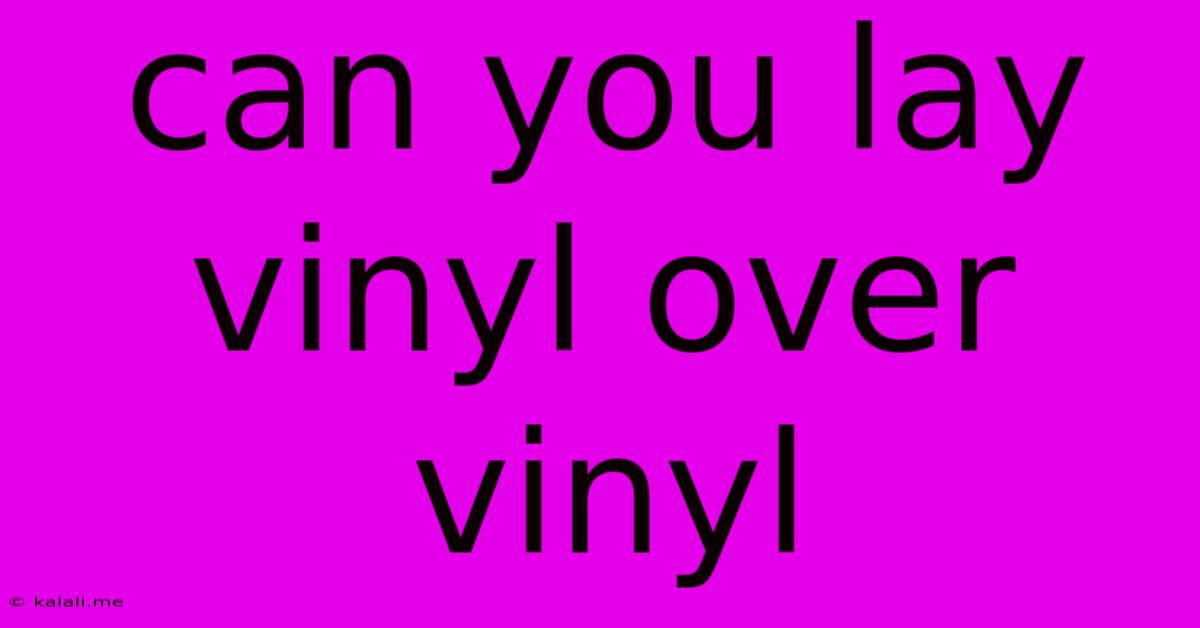Can You Lay Vinyl Over Vinyl
Kalali
May 21, 2025 · 4 min read

Table of Contents
Can You Lay Vinyl Over Vinyl? A Comprehensive Guide
Meta Description: Wondering if laying vinyl over existing vinyl flooring is possible? This guide explores the pros, cons, and crucial factors to consider before undertaking this DIY project. Learn about substrate preparation, choosing the right vinyl, and potential pitfalls to avoid.
Laying new vinyl flooring over existing vinyl can seem like a quick and cost-effective way to update your floors. However, this isn't always the best approach. This comprehensive guide will explore the feasibility of this project, highlighting the advantages, disadvantages, and crucial steps to ensure success (or avoid a costly mistake).
The Allure of Layering Vinyl: Time and Cost Savings
The primary appeal of installing vinyl over vinyl is its potential to save time and money. Removing old vinyl flooring can be a laborious and messy process, often requiring specialized tools and potentially revealing underlying subfloor imperfections. Layering avoids this hassle, potentially completing the project faster and cheaper.
Factors to Consider Before Laying Vinyl Over Vinyl
However, before you grab your new vinyl rolls, carefully consider these crucial factors:
-
The Condition of the Existing Vinyl: This is the most critical aspect. The existing vinyl must be clean, smooth, firmly adhered to the subfloor, and free from damage like bumps, cracks, or excessive adhesive residue. Any imperfections will be transferred to the new flooring, resulting in an uneven and potentially short-lived installation. Severe damage necessitates removal of the old vinyl.
-
Type of Existing Vinyl: The type of existing vinyl plays a crucial role. Sheet vinyl generally provides a better base than vinyl tiles due to its seamless nature. The thickness of both the existing and new vinyl is also relevant. A thicker underlayment might be needed if the existing vinyl is thin.
-
Thickness of the New Vinyl: Choosing the right thickness is vital. Extremely thin vinyl may show imperfections in the underlying vinyl, leading to an uneven surface. A thicker vinyl offers better durability and hides imperfections more effectively. Consider the overall height increase and potential impact on doors and transitions.
-
Subfloor Condition: Although you're laying over existing vinyl, the condition of the underlying subfloor remains relevant. A damaged subfloor will compromise the longevity and stability of both the old and new vinyl flooring. Assess for any moisture, unevenness, or structural issues.
-
Type of New Vinyl: Different types of vinyl flooring, such as luxury vinyl plank (LVP), luxury vinyl tile (LVT), and sheet vinyl, each have varying requirements and compatibility with existing vinyl. Research your specific vinyl type for guidance.
Pros and Cons of Layering Vinyl Over Vinyl
Pros:
- Cost-effective: Avoids the cost and labor associated with removing old vinyl.
- Time-saving: Faster installation compared to complete removal and replacement.
- Less messy: Minimizes dust and debris associated with demolition.
Cons:
- Potential for unevenness: Imperfections in the underlying vinyl can transfer to the new flooring.
- Reduced durability: The combined thickness may be less durable than a single layer of thicker vinyl on a clean subfloor.
- Limited warranty: Manufacturers' warranties may be voided if installed over existing flooring.
- Increased risk of moisture problems: Trapping moisture between layers can lead to mold and mildew growth.
Preparing the Existing Vinyl for New Installation
Even if you decide to proceed, thorough preparation is crucial. This involves:
- Thorough cleaning: Remove all dirt, debris, and adhesive residue.
- Surface repair: Fill any small cracks or holes with a suitable filler.
- Moisture testing: Ensure the subfloor is dry to prevent moisture problems.
- Priming (if necessary): Some primers can help improve adhesion.
Alternatives to Layering Vinyl Over Vinyl
If the existing vinyl is in poor condition or you're concerned about potential problems, consider these alternatives:
- Complete removal and replacement: While more labor-intensive, it guarantees a clean, level surface for the new vinyl.
- Self-leveling compound: This can address minor unevenness in the existing vinyl before installing the new flooring.
Ultimately, the decision of whether or not to lay new vinyl over existing vinyl depends on a careful assessment of the factors discussed above. While it can be a viable option in certain situations, prioritizing proper preparation and choosing the right type of vinyl is essential to avoid costly mistakes and ensure a successful outcome.
Latest Posts
Latest Posts
-
How To Make Coconut Milk From Coconut Cream
May 21, 2025
-
Can You Carry Coffee On A Plane
May 21, 2025
-
Is A Light Wave A Transverse Wave
May 21, 2025
-
What Can Go Down A Chimney Up
May 21, 2025
-
How To Remove Vinyl Tile Adhesive
May 21, 2025
Related Post
Thank you for visiting our website which covers about Can You Lay Vinyl Over Vinyl . We hope the information provided has been useful to you. Feel free to contact us if you have any questions or need further assistance. See you next time and don't miss to bookmark.